User Roles and Privileges
Source:vignettes/User_Roles_and_Privileges.Rmd
User_Roles_and_Privileges.RmdStarting with version 1.0.0, there has been a major overhaul on how privileges function within the application. Privileges are now tied to a user’s role, and the person responsible for deploying the application can create custom roles, compiled with any combination of privileges! These user-defined roles allows the most flexibility to manage a user’s access & ability in the app. For purposes of discussion, the default configuration will be used as reference. For more information see the “Deployment” guide.
Below is a snippet from the inst/db-config.yml file
where the default roles are defined with privileges we’ll discuss in
this article:
privileges:
admin: [admin, weight_adjust, auto_decision_adjust, final_decision, revert_decision, add_package, delete_package, overall_comment, general_comment]
lead: [weight_adjust, auto_decision_adjust, final_decision, revert_decision, add_package, delete_package, overall_comment, general_comment]
reviewer: [add_package, general_comment]
viewer:Privileges
At the time this vignette was authored, there are eight different privileges that can be assigned to a role:
-
Administrator
(
admin): manages the users of the application -
Weight
Adjustment (
weight_adjust): manages the weights applied to the riskmetric risk calculation -
Automated
Decision Adjustment (
auto_decision_adjust): manages the decision automation rules and decision category display colors -
Final
Decision (
final_decision): makes final decisions regarding packages -
Revert
Decision (
revert_decision): can undo a final decisions made regarding packages -
Add
Packages (
add_package): adds packages for consideration -
Delete
Packages (
delete_package): can remove packages from consideration -
Overall
Commentator (
overall_comment): can add/edit the overall comment and summary for a package -
General
Commentator (
general_comment): can add maintenance and community metric comments
Administrator
Basically, the admin privilege allows a user to manage
the credentials and privileges of other users. The credential-heavy
features of the admin privilege are discussed at length in
“Credential Manager”
guide. Please reference that vignette for more information.
Weight Adjustment
The weight_adjust privilege allows a user to change the
weights applied to the riskmetric risk calculation. These
options can be found under Assessment Reweighting in the
Administrative Tools tab. Here is a high level view:
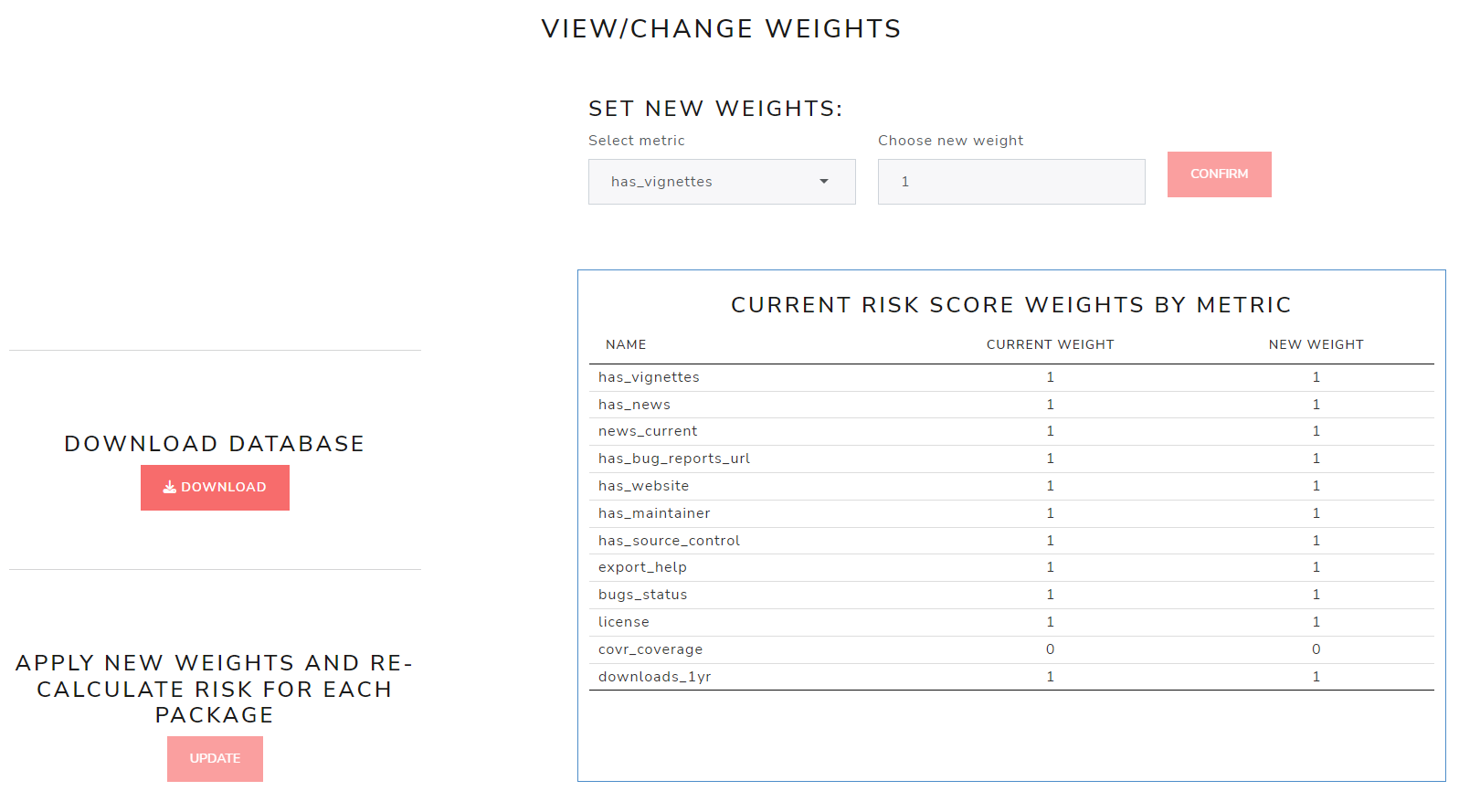
There are three buttons on this page: CONFIRM on the top right, DOWNLOAD on the middle left, and UPDATE on the bottom left.
Download Database
First, the simplest: the DOWNLOAD database button.
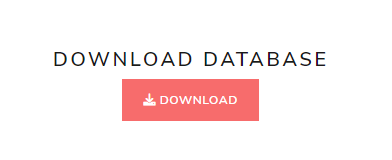
When clicked, this button will download a copy of the current database (by default, called “database.sqlite”). The app developers recommend doing this anytime you plan to make integral changes to the database (like changing metric weights), before anything else.
Updating Weights
The CONFIRM button allows
you to view existing and change metric weights used to calculate a risk
score using riskmemtric.

Here you can either select a metric from the
Select metric dropdown box or select a row in the
“CURRENT RISK SCORE WEIGHTS BY METRIC” table.
Once the metric is selected, enter a new (numeric) weight in the “Choose new weight” box and click the CONFIRM button. You’ll notice the row with the change will appear highlighted, showing you the old weight value and the new weight value:
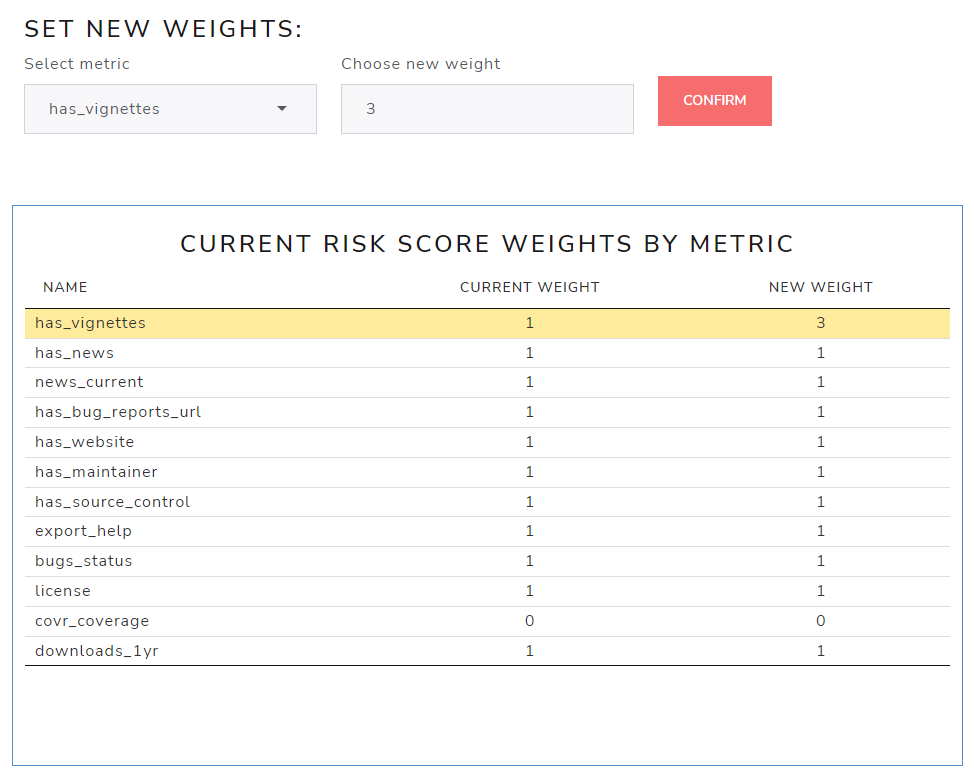
After you have updated at least one metric weight, the UPDATE button is enabled, allowing you to apply new weights and re-calculated the risk for each package.
After you’ve made all final re-weighting changes, you can click the “Update” button pictured here. Note that these weight changes will take effect on all packages in the database, updating the risk score for each.
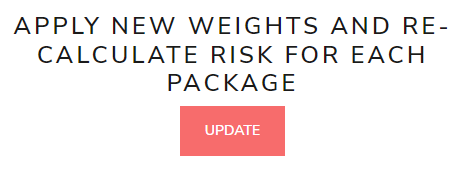
Once you click on UPDATE you will get a confirmation modal, reminding you that “updating the risk metrics cannot be reverted”, and strongly recommending you download a copy of the current database first before clicking on SUBMIT. The modal also details all the actions that will take effect in the app if you submit these changes. Note that starting with Version 1.0.0, this will be a re-calculation on the stored riskmetric assessments, not a re-assessment.
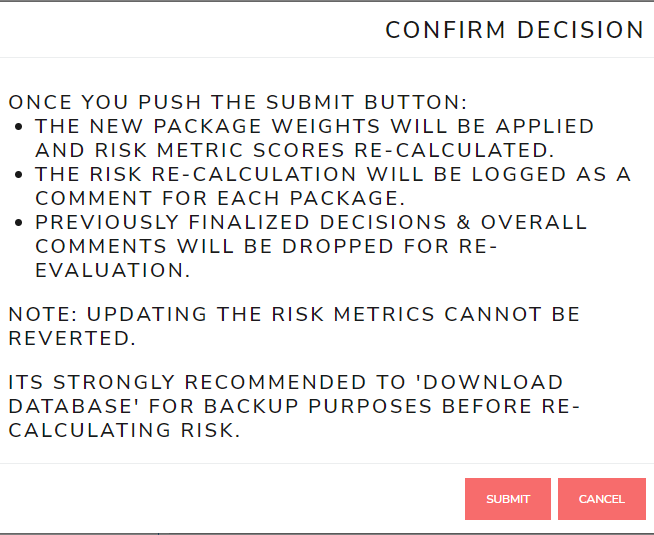
Once you click on SUBMIT a modal dialog box will appear indicating that it is applying weights and updating risk scores to each package you have uploaded. This will be followed by a brief “updates completed” message.

Now go to the database overview tab to confirm that the risk scores
have been updated. You can also view the new weights, including the
standardized weight on the Assessment Criteria tab.
Automated Decision Adjustment
Users with the auto_decision_adjust privilege can edit
decision automation rules and decision category colors. If your
organization has black and white rules about package risk decisions
based solely on riskmetric scores, then decision automation
is for you. When leveraged, it will help you automatically classify
packages into the “Low Risk”, “Medium Risk”, or “High Risk” decision
categories upon upload (for the default configuration). The current
automation rules are accessible in two locations: under ‘Upload Package’
in the Risk Assessment tab & under ‘Decision
Categories’ in the Database tab. To get started, click on
the small
(gear) button in the upper right hand corner of either section.
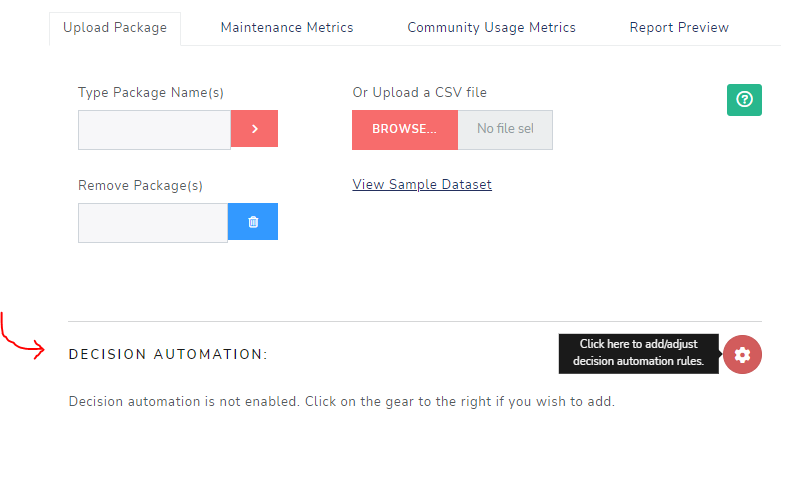
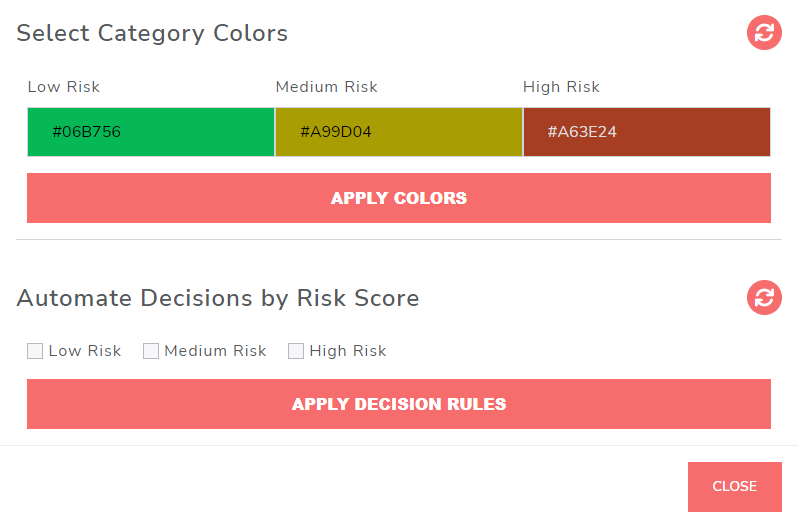
Select Category Colors
To change the color for one of your decision categories, select a new color by either typing in the desired hexidecimal code or use the color input.
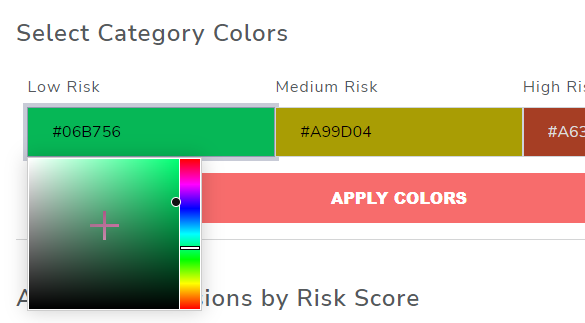
To apply these changes, click APPLY COLORS. A pop-up will ask the user to review and confirm the selection:
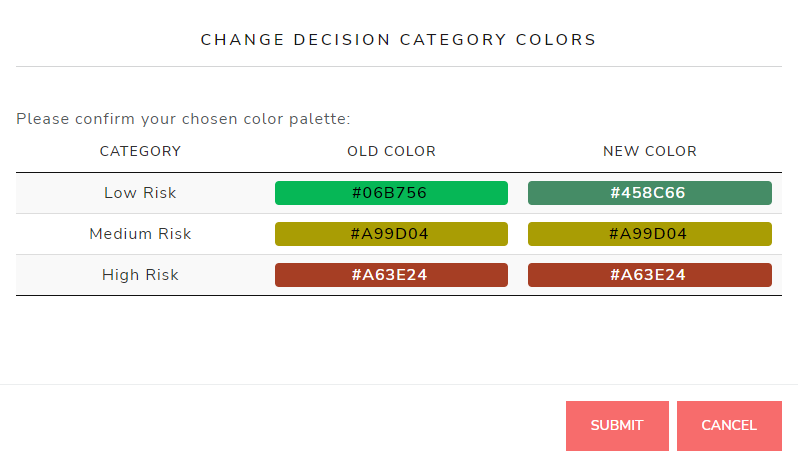
The modal contains a summary of all decision categories with their respective new colors. If you are happy with your selections, simply click SUBMIT and the database and application will be updated with your selections.
Automate Decision by Risk Score
If there are no decision rules applied, you’ll see the following decision categories adjacent empty check boxes. When setting up these rules for your organization, you can choose as much or as little automation as desired.
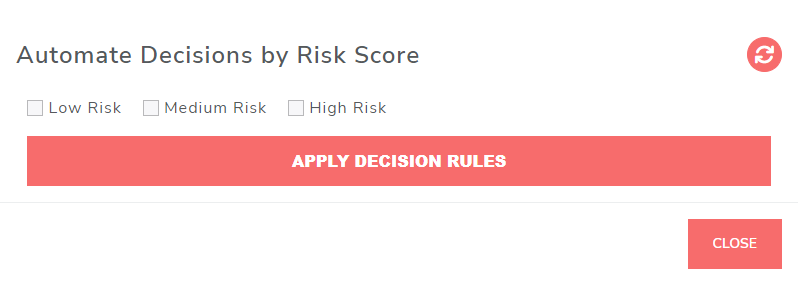
For example, if you want to set up an automatic decision for “High Risk” scores, you only need to select that check box and make your risk score designation / cut off value. From then on, every time a package is uploaded with a risk score > 0.67, it will automatically receive the decision label: “High Risk” which saves your review team time and mental capacity when reviewing large groups of packages.
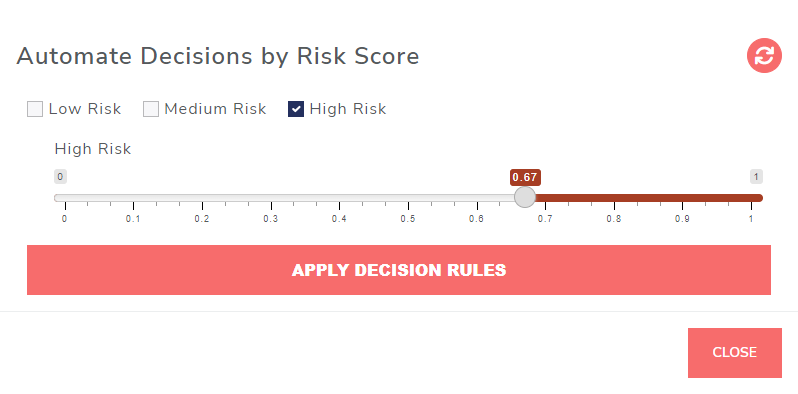
Similarly, if you have package risk thresholds mapped out for each decision category, then apply them here! The user interface won’t allow the slider ranges to overlap, but it will allow gaps between each range. In the example below, we adopt automatic decisions for packages with risk scores less than 0.33 and greater than .67. In this fictitious example, let’s say our organization has a policy that any package whose risk score falls between 0.33 and 0.67 will need to be reviewed manually.
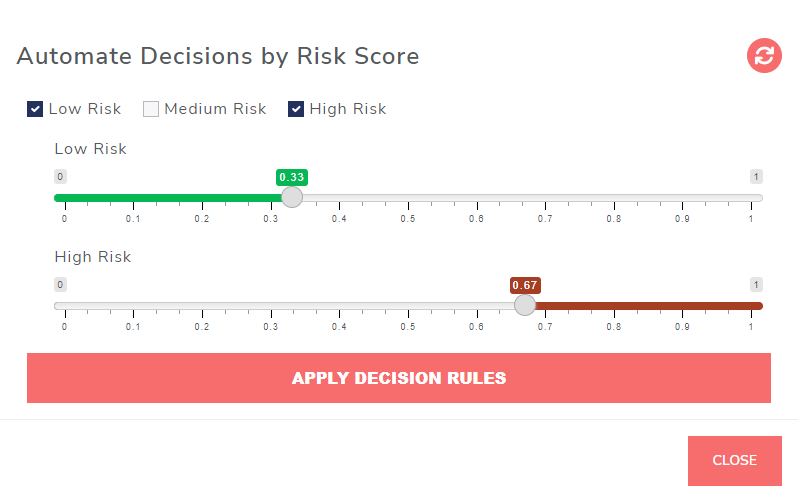
To apply these changes, click APPLY DECISION RULES. A pop-up will ask the user to review and confirm the selected automation rules:
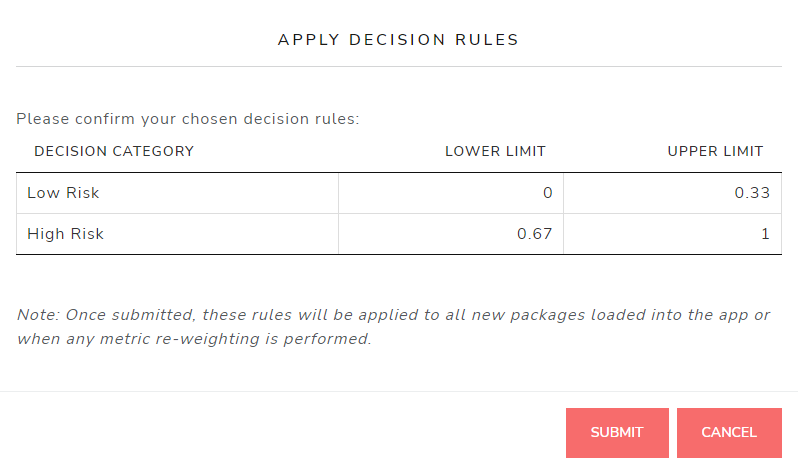
Upon clicking submit, the automation rules will be stored for all users to see on the ‘Upload Package’ tab. After uploading a new set of packages, you can see the ‘Summary of Uploaded Package(s)’ now includes a summary of decisions made and each category it was automatically assigned. In the example below, you can see that 10 packages were uploaded, and 7 automatic decisions were made: six received the “low risk” designation and one was labeled as “high risk”. In the summary table, you can note the risk score and decision on the right-hand side. You can also observe that a few packages weren’t found because they don’t exist on CRAN.
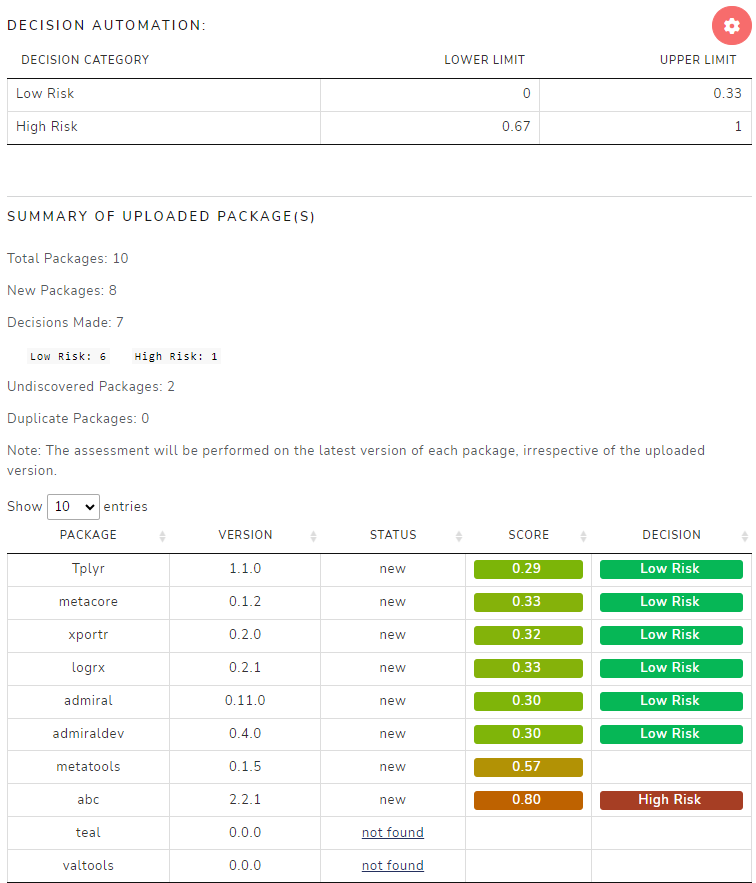
In the ‘PACKAGE CONTROL PANEL’, if we select one of the packages where a decision was made, you will see that the ‘Status’ has been changed to “Reviewed” and the risk decision slider has been adjusted accordingly and disabled. In addition, an ‘Overall Comment’ was submitted, stating that the decision made was driven via the automation rules.
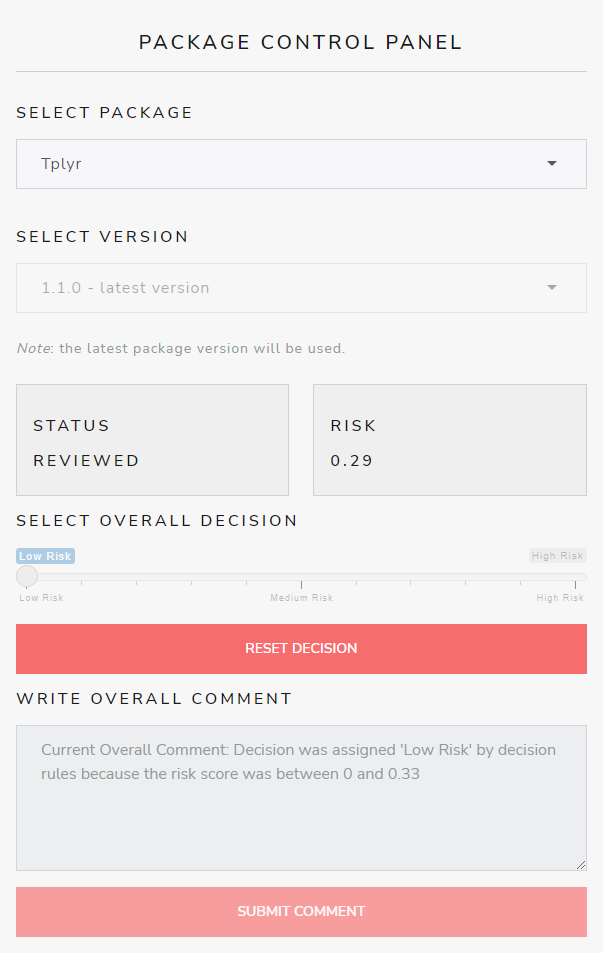
Final Decision
As the name suggests, a user with the final_decision
privilege can make final decisions as to which category a package should
be assigned. Overall comments regarding the package are also tied to
this privilege.
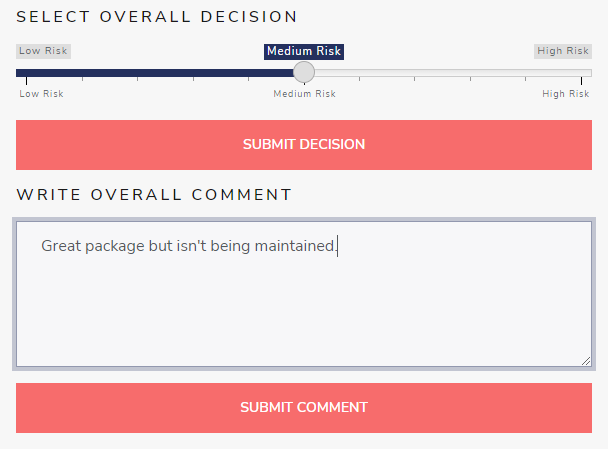
Revert Decision
A user with the revert_decision privilege can undo a
final decision after it has been made. Doing so will set the package’s
status to “under review” and will re-enable “overall comments” regarding
the decision.

Add Packages
A user with the add_package privilege can upload
packages to the database for consideration.

Delete Packages
A user with the delete_package privilege can remove
packages from consideration (the database).
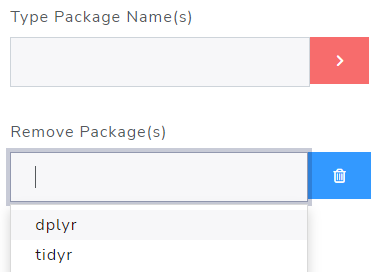
Overall Commentator
A user with the overall_comment privilege can add/edit
two optional high-level summaries for a package:
- First, the “Overall Comment”, located on the sidebar, is an outlet for users to specify a quick synopsis related to the package decision, and
- The Package Summary, located on the “Build Report” tab, allows a user to compose a long-form, open-ended summary of their evaluation / review process for the package of interest
Unlike maintenance or community usage metrics, each package can only have one entry for “Overall Comment” and “Package Summary”.
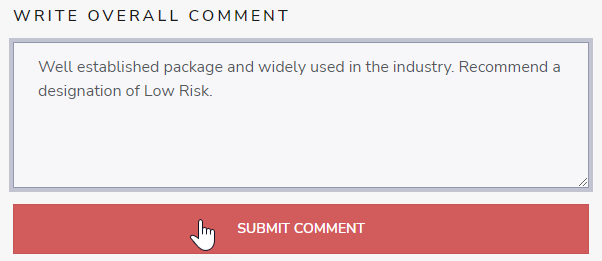
Roles
User roles group select privileges together providing users with
different, but not necessarily mutually exclusive, access to the
application. The default configuration contains four user roles:
admin, lead,
reviewer, viewer. Here is a snippet
from the inst/db-config.yml file where these roles are
defined:
privileges:
admin: [admin, weight_adjust, auto_decision_adjust, final_decision, revert_decision, add_package, delete_package, overall_comment, general_comment]
lead: [weight_adjust, auto_decision_adjust, final_decision, revert_decision, add_package, delete_package, overall_comment, general_comment]
reviewer: [add_package, general_comment]
viewer:In this configuration, an admin user has access to the entire application, a lead user has access to all privileges except administrative ones (e.g. managing user credentials), a reviewer only has the privilege to add packages for consideration and adding comments/descriptions, and a viewer can only view the current state of assessment. An organization can customize these user roles to support their needs. For more information please reference the “Deployment” guide.
